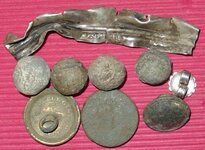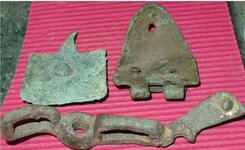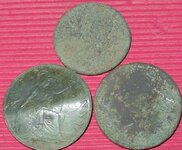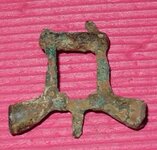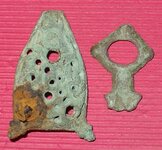CRUSADER
Gold Member
Went to explore a couple of fields next to the river. On the map they look great as they lay between the villiage & the river. When we got there we were a bit worried as what we had thought to be set-a-side was really an over grown mess that hasn't seen a crop for several year. The first field was unworkable, the second on the high ground which I liked the looks of was only workable in a few areas & even then it was hard work swinging the head around all the 3 foot high weeds. Dad started with a great find of a Saxon Strap Junction fragment (First ever). Close by I got a Early Medieval or Saxon Strap junction of a type I need to research. Whilst doing this field I pointed out that he had moved some large areas of mud. We investigated & found the farmer had deepen and widen the ditches. We immediately started searching the scrap. Dad got a mystery early Iron Age piece (cica 100BC) & as I started to wonder if I had the raw end of the stick being in the deepest part of the slope where the clay seemed to be natural, out popped a Viking/Saxon Stirrup Mount over 2 foot below the normal soil level. (nice to find a piece which has laid in the same spot for 1000 years until I came along  . This has been a dream of mine for some years & ticks no.3 off my wish list.
. This has been a dream of mine for some years & ticks no.3 off my wish list.
Picture 1:
Silver - hallmarked Birmingham 1831
4 Pistol Shots
Guinea Coin weight
Picture 2:
Top left - Medieval Horse Pendant
Top right - Saxon/Medieval Buckle plate
Bottom - Strap junction (I found)
Picture 3:
1799 Halfpenny
Geo II Halfpenny
1922 Penny
Picture 4:
Mystery Iron Age piece
Picture 5:
Left - 9th-11th century - Anglo-Sandinavian (Viking) / Saxon Stirrup Mount - Class A, Type 10C - Only 3 of this openwork type recorded in Williams book on Stirrup Mounts. All 3 are totally degraded & mine is in far better condition & has an interesting story. It has strong Sandinavian (Viking) influence with the Urnes style coiled animal. Head at apex, but also 2 projecting heads at the base. The magic & art of these pieces were more important than the function & the apex loops often broke off like this one. However its been re-used with a drilled hole further down the piece showing the expense & importance it had.
Right - Saxon/Viking Strap junction piece.
If you think I'm pleased, you're be understanding the truth








 . This has been a dream of mine for some years & ticks no.3 off my wish list.
. This has been a dream of mine for some years & ticks no.3 off my wish list.Picture 1:
Silver - hallmarked Birmingham 1831
4 Pistol Shots
Guinea Coin weight
Picture 2:
Top left - Medieval Horse Pendant
Top right - Saxon/Medieval Buckle plate
Bottom - Strap junction (I found)
Picture 3:
1799 Halfpenny
Geo II Halfpenny
1922 Penny
Picture 4:
Mystery Iron Age piece
Picture 5:
Left - 9th-11th century - Anglo-Sandinavian (Viking) / Saxon Stirrup Mount - Class A, Type 10C - Only 3 of this openwork type recorded in Williams book on Stirrup Mounts. All 3 are totally degraded & mine is in far better condition & has an interesting story. It has strong Sandinavian (Viking) influence with the Urnes style coiled animal. Head at apex, but also 2 projecting heads at the base. The magic & art of these pieces were more important than the function & the apex loops often broke off like this one. However its been re-used with a drilled hole further down the piece showing the expense & importance it had.
Right - Saxon/Viking Strap junction piece.
If you think I'm pleased, you're be understanding the truth









Attachments
Upvote
0


